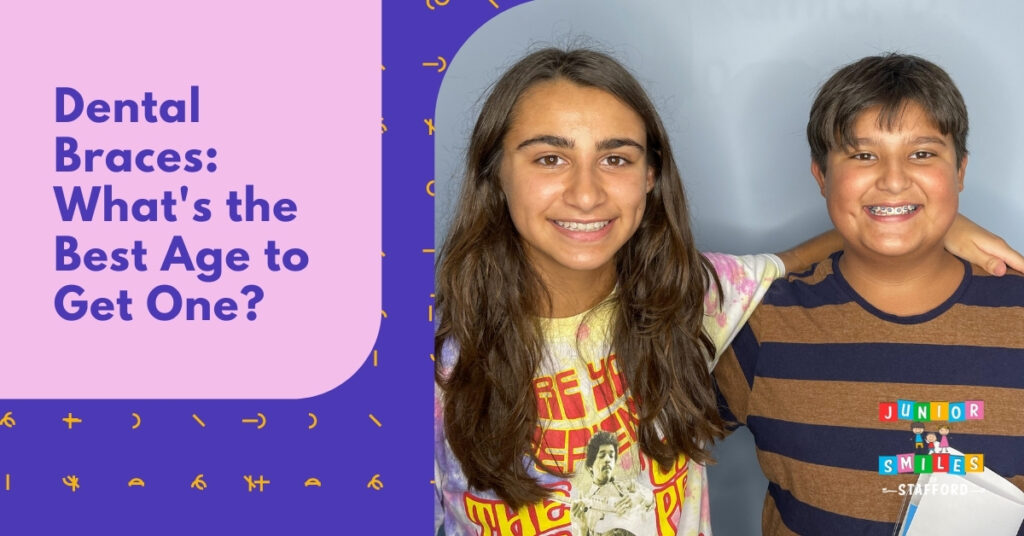Dental Braces: What’s The Best Age To Get One?

Embarking on the journey towards a perfect smile with dental braces is an important decision, and one of the key questions many patients and parents ponder is: What’s the best age to get braces? This crucial question merits a comprehensive answer, as the right age can vary significantly based on individual dental health, the severity of orthodontic issues, and personal goals.
In this comprehensive guide, we’ll dive into the world of dental braces, examining the factors that influence the ideal age for starting this transformative treatment. Whether you’re a teenager considering braces or a parent contemplating this step for your child, our insights will help you make an informed decision for achieving that dream smile.
Why Do Kids Need Braces?
Braces are not just for improving the appearance of your child’s smile; they play a crucial role in correcting dental and oral health issues. One of the primary reasons kids need braces is to correct malocclusion, which is when the teeth are not aligned properly.
The misalignment can cause issues with chewing, speaking, and maintaining oral hygiene. Crowded or overlapping teeth, a common problem in children, are harder to clean and can increase the risk of cavities and gum disease. Additionally, braces can correct bite issues, such as overbites, underbites, and crossbites, which can affect jaw alignment and function.
Psychologically, having straightened teeth can significantly boost your child’s self-esteem. Children with orthodontic issues may feel self-conscious about their appearance, impacting their confidence and social interactions. Braces can help address these concerns, improving not only their oral health but also their overall well-being.
What is the Best Age to Get Braces?
The optimal age for braces generally falls between 9 and 14 years old. This age range is ideal because most children have lost most of their baby teeth, and the majority of their permanent teeth have erupted. However, the exact timing for braces can vary greatly depending on individual dental development and specific orthodontic issues. That is why early orthodontic assessment is crucial in determining the most appropriate time for treatment.
The American Association of Orthodontists recommends that children have their first check-up with an orthodontist no later than age 7. While this does not mean they will get braces immediately, it allows for early monitoring and intervention at the optimal time.
In some cases, children may benefit from early intervention, known as Phase 1 orthodontics. This can start as early as age 6 or 7 and addresses jaw growth and emerging bite problems. Phase 1 orthodontics can sometimes simplify or shorten the time needed for further orthodontic treatment in the future.
Benefits of Wearing Braces
Aside from straighter teeth, here are some benefits you could get upon wearing braces. These are also for adults who experience misaligned teeth.
Improved Oral Health
One of the most significant benefits of wearing braces is the improvement in overall oral health. Crooked or crowded teeth can overlap, creating hard-to-clean gaps and leading to issues like cavities and gum disease. Braces help straighten and properly spread your teeth, making them easier to clean and maintain.
Enhanced Confidence
Misaligned teeth can impact self-esteem, especially in children and teenagers. Braces bring out confident smiles by aligning the teeth beautifully.
Post-treatment, you’ll likely notice a boost in your child’s confidence, as they’ll feel more comfortable with their smile.
Prevention of Bone Erosion
Misaligned teeth can cause bone erosion due to bacteria eating away at the bones. Braces help stretch periodontal ligaments and nerves, allowing the bones to recover naturally once the teeth are properly aligned.
Better Speech and Chewing
Misaligned teeth can affect speech and chewing. Braces correct these issues, leading to clearer speech and more efficient chewing, essential for proper digestion and overall health.
Long-Term Dental Health
By correcting orthodontic issues early in life, braces set the stage for long-term dental health, reducing the risk of more serious dental problems in the future.
Signs Your Child Is Ready for Braces
Do you think your kid is a candidate for braces? It would be best to talk to an orthodontist and ask for their professional suggestions on when your child should get braces treatments.
Here are four signs you should look for to know if your child is ready for getting one.
Loss of Baby Teeth
Most orthodontists prefer to start treatment after the majority of baby teeth have fallen out. If your child has lost all their baby teeth except one or two, it might be time to consider braces.
Early consultations with an orthodontist are recommended as soon as the first adult teeth appear.
Crowded or Misaligned Teeth
If your child’s adult teeth are significantly crowded and misaligned, or if there’s an overbite, it’s a clear sign that they might need braces. Early intervention can prevent damage to adult teeth and may shorten the duration of treatment.
Difficulty in Chewing or Biting
Observe if your child has difficulty in chewing or biting or if they often bite their cheek or the roof of their mouth. These can be indicators of misalignment that braces can correct.
Molars Eruption
Orthodontists often wait for the child’s 12-year molars to at least partly erupt before starting braces. These molars can affect the alignment of other teeth, so it’s crucial to consider their position and growth.
Read More: A Guide on Types of Pediatric Braces
How Much Do Kids Braces Cost?
The cost of braces for kids varies widely, but on average, it ranges from $3,000 to $10,000. This cost can depend on several factors, including the type of braces (metal, ceramic, lingual, or clear aligners), the complexity of the dental issues being addressed, and the geographic location of the orthodontic practice.
Many dental insurance plans offer coverage for orthodontic treatment, which can significantly reduce out-of-pocket expenses. Additionally, many orthodontic practices offer payment plans or financing options to make the treatment more affordable.
Here’s a range of how much it would cost:
- Metal braces (traditional braces): $3,000 – 7,000
- Ceramic braces: $4,000 – 8,000
- Lingual braces: $8,000 – 10,000
- Invisalign: $4,000 – 7,400
How Long is Orthodontic Treatment?
On average, children can expect to wear braces for about 1 to 3 years. The exact duration of treatment depends on various factors, including the severity of the orthodontic issues, the type of braces used, and how well the child adheres to the treatment plan, including maintaining good oral hygiene and attending regular check-ups.
After the active phase of treatment with braces, the retention phase begins. Wearing a retainer as prescribed is crucial to prevent teeth from shifting back to their original positions.
The length of time a retainer is needed will depend on the individual case, but it’s a critical step in ensuring the long-term success of the orthodontic treatment. Regular follow-up appointments are important to monitor progress and ensure the best results.
Begin Your Child’s Journey to a Perfect Smile at Junior Smiles of Stafford
Is your child showing signs that they might need braces, or are you simply curious about their orthodontic health? At Junior Smiles of Stafford, we’re here to guide you every step of the way. Our experienced team offers comprehensive care and personalized treatment plans tailored to your child’s unique needs.
Don’t wait to address potential orthodontic issues. Schedule an appointment today for a consultation and start your child on the path to a healthy, beautiful smile.
Contact us to learn more about our services and how we can help make your child’s smile brighter and healthier.

